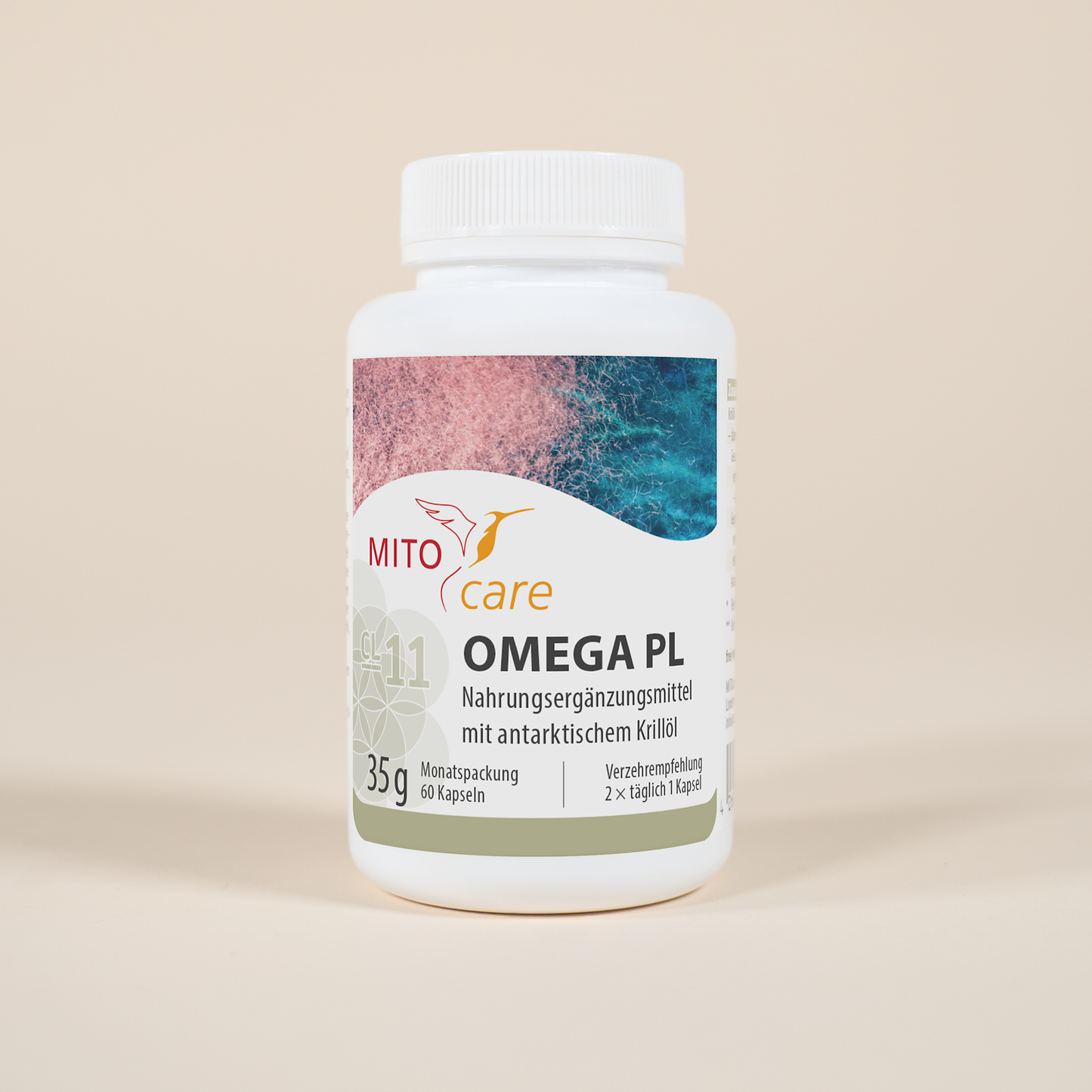Themen dieses Blogartikels:
Table of contents
- Definition: What is DHA?
- What functions does DHA have?
- What makes DHA unique?
- How much DHA do you need per day?
- When do you especially need Omega-3, such as DHA?
- How does a DHA deficiency arise and how does it manifest itself?
- What should you pay attention to when taking DHA?
- Which foods contain particularly high levels of DHA?
- Sources & Bibliography
Definition: What is DHA (docosahexaenoic acid)?
DHA is the abbreviation for docosahexaenoic acid. It is a polyunsaturated fatty acid from the omega-3 fatty acid group. Its molecular formula is C22H32O2. The long-chain docosahexaenoic acid has six double bonds, which exist in the cis form. The colorless, liquid oil is insoluble in water and has a melting point of -44.5°C.¹
Along with docosahexaenoic acid, alpha-linolenic acid (ALA) and eicosapentaenoic acid (EPA) are among the omega-3 fatty acids. Alpha-linolenic acid (ALA) is essential and must therefore be supplied to the body through food. This vital nutrient is found in plant-based foods such as rapeseed oil, flaxseed, and walnut oils. Your body converts ALA first into EPA and then into DHA – but only in small amounts.² ALA is therefore a precursor to EPA and DHA, respectively. Almost all animal species have the ability to synthesize DHA.
Contained in fish
Good to know: Eicosapentaenoic acid (EPA) and docosahexaenoic acid (DHA) are the most biologically active omega-3 fatty acids. They can also be absorbed directly through the diet. DHA is produced by microalgae such as Schizochytrium and Ulkenia, which are then consumed by cold-water fish such as salmon, mackerel, and herring – this is how the fatty acid enters their bodies. By including these fish in your diet once or twice a week, you supply your body with valuable omega-3 fatty acids.³ Alternatively, dietary supplements are available in the form of tablets, capsules, and oils.
What functions does DHA have?
Docosahexaenoic acid is an important building block in the nerve cells of the brain and in the photoreceptors in the eye: Up to 97 percent of the omega-3 fatty acids in the brain and up to 93 percent of the omega-3 fatty acids in the retina are DHA.⁴ For this reason, DHA contributes to normal brain function and normal vision.⁵
But this special fatty acid can do even more: Initial studies have shown that DHA can lower blood pressure and heart rate in overweight people.⁶ Therefore, the U.S. Food and Drug Administration (FDA) allows the claim that DHA can reduce the risk of high blood pressure and coronary heart disease (CHD).⁷ Accordingly, DHA could contribute to longevity. In Germany, dietary supplements containing this nutrient may only be advertised with the claim that omega-3 fatty acids such as DHA contribute to normal heart function.⁸
What makes docosahexaenoic acid (DHA) unique?
Various studies suggest that DHA may have a positive effect on memory, learning, and concentration.⁹ This effect is likely due to the fact that docosahexaenoic acid plays a significant role in the transmission of signals between neurons and in the maintenance of synapses.¹⁰ Furthermore, DHA contributes to the maintenance of normal blood cholesterol levels by lowering "bad" LDL cholesterol and increasing "good" HDL cholesterol. For this reason, DHA may be of interest for the prevention of cardiovascular disease and promote heart health.¹¹
DHA is particularly important for women's health and the health of unborn and newborn babies. Did you know? The conversion of alpha-linolenic acid to docosahexaenoic acid is more effective in women than in men. This long-chain fatty acid is crucial for the child's healthy brain development and vision. Since fetuses and infants are not yet able to produce EPA and DHA from ALA themselves, they rely on their supply via the placenta or breast milk.¹²
How much DHA do you need per day?
Because the body can produce DHA itself, the German Nutrition Society (DGE) does not provide a general recommendation for daily intake. The DGE has only established a reference value for its precursor, alpha-linolenic acid. This value is based on the individual's energy or calorie intake and is therefore expressed as a percentage: For all age groups, from infants and children to adolescents and adults, the DGE recommends that ALA should make up 0.5 percent of their individual daily energy needs.¹³
Assuming an average daily energy intake of 2400 kcal for a healthy adult, this corresponds to 1.3 g of ALA per day.¹⁴ The recommended amount is found, for example, in one tablespoon of rapeseed oil or one teaspoon of linseed oil.¹⁵
When do you especially need omega-3 fatty acids like DHA?
Pregnant and breastfeeding women, in particular, have an increased need. This is because the unborn or newborn child depends on the mother's adequate supply of this vital fatty acid. The child's body cannot yet produce DHA from ALA. Since DHA is considered an essential nutrient for the healthy development of the baby, pregnant and breastfeeding women should consume at least 200 mg of DHA per day, recommends the DGE. Furthermore, the intake of omega-3 fatty acids can reduce the risk of premature birth.¹⁶ If you have any questions about this, consult your gynecologist.
Since DHA is found almost exclusively in animal products such as fish, vegetarians and vegans should also ensure they meet their needs. One option for this is DHA-containing supplements from plant sources such as algal oils.¹⁷
How does a DHA deficiency arise and how does it manifest itself?
For the body's conversion of ALA to DHA to function smoothly, your body needs various micronutrients such as vitamin C, zinc, magnesium, biotin, vitamins B3, and B6. A deficiency in these can lead to a deficiency in this important omega-3 fatty acid.¹⁸
Excessive levels of omega-6 fatty acids such as linoleic acid also impede DHA synthesis. Linoleic acid is found in many vegetable oils such as sunflower, wheat germ, and safflower oil, which can quickly lead to an imbalance between omega-3 and omega-6 fatty acids in the body.¹⁹
People with elevated cholesterol levels and/or diabetes are also at risk for deficiency. In older individuals and during periods of increased stress, the synthesis of DHA from its precursors can also be impaired. Possible consequences include an increased risk of cardiovascular disease, visual impairment, and increased susceptibility to infections. In children, cognitive impairment or developmental disorders can occur.²⁰
What should you pay attention to when taking DHA?
Many dietary supplements combine the most biologically active omega-3 fatty acids EPA and DHA. According to an opinion from the European Food Safety Authority (EFSA), there are no safety concerns for healthy adults when taking these combination products, provided the maximum daily dose of 5 grams is not exceeded. Nausea and heartburn are among the few side effects observed so far.²¹
If you suffer from heart disease, you should only take DHA after consulting your doctor. According to the German Federal Institute for Risk Assessment (BfR), dietary supplements containing omega-3 fatty acids can increase the risk of dangerous atrial fibrillation.²² Diabetics and people taking anticoagulant medications should also consult their doctor before taking DHA supplements.²³
Which foods contain particularly high levels of DHA?
The best sources are fatty fish such as sardines, salmon, herring, mackerel, sprat, and tuna. Low-fat fish such as trout, cod, and haddock have slightly lower levels.
Did you know? Fish from aquaculture usually require DHA supplementation, for example, through fishmeal or fish oil from marine fish.²⁴ Wild-caught marine fish feed on DHA-rich algae, plankton, and krill—small shrimp and invertebrates that are not found in farmed fish farms.
This encyclopedia entry is based on carefully researched sources:
Bibliography & Sources
- chemie.de/lexikon/Docosahexaens%C3%A4ure.html
- ak-omega-3.de/omega-3-fettsaeuren/wo-sind-omega-3-fettsaeuren-enthalten/
- ak-omega-3.de/omega-3-fettsaeuren/wo-sind-omega-3-fettsaeuren-enthalten/
- flexikon.doccheck.com/de/Docosahexaens%C3%A4ure
- klartext-futterrgaenzung.de/wissen/lebensmittel/futterrgaenzmittel/omega3fettsaeurekappen-sinnviele-futterrgaenzung-8585
- pmc.ncbi.nlm.nih.gov/articles/PMC3607063/
- fda.gov/food/hfp-constituent-updates/fda-announces-new-qualified-health-claims-epa-and-dha-omega-3-consumption-and-risk-hypertension-and
- klartext-futterrgaenzung.de/wissen/lebensmittel/futterrgaenzmittel/omega3fettsaeurekappen-sinnviele-futterrgaenzung-8585
- flexikon.doccheck.com/de/Docosahexaens%C3%A4ure
- vitalstoff-lexikon.de/Fettsaeuren/Docosahexaensaeure-DHA/Functions
- vitalstoff-lexikon.de/Fettsaeuren/Docosahexaensaeure-DHA/Functions
- ugb.de/ernaehrungsplan-praevention/omega-3-fettsaeuren-ins-essen/
- wdge.de/science/reference values/fat-essential-fatty acids/
- cardiopraxis.de/omega-3-fettsaeuren-increased-risk-of-atrial-fibrillation-at-high-dosage/
- consumingservice-bayern.de/themen/ernaehrung/omega-3-fettsaeuren-unter-der-lupe-3374
- deutsche-apotheker-zeitung.de/news/artikel/2023/01/04/dha-in-der-schwangerschaft-wofuer-und-wieviel
- vitalstoff-lexikon.de/Fettsaeuren/Docosahexaensaeure-DHA/Risk groups
- imd-berlin.de/fachinformation/diagnostikinformation/fettsaeurestatus-der-erythrocytemembrane
- ak-omega-3.de/omega-3-fettsaeuren/wo-sind-omega-3-fettsaeuren-enthalten/
- vitalstoff-lexikon.de/Fettsaeuren/Docosahexaensaeure-DHA/Risk groups
- klartext-futterrgaenzung.de/wissen/lebensmittel/futterrgaenzmittel/omega3fettsaeurekappen-sinnviele-futterrgaenzung-8585
- bfr.bund.de/cm/343/praeparate-mit-omega-3-fettsaeuren-koennen-bei-herzpatienten-das-risk-fuer-vorhofffibriller-erhoehen.pdf
- klartext-futterrgaenzung.de/wissen/lebensmittel/futterrgaenzmittel/omega3fettsaeurekappen-sinnviele-futterrgaenzung-8585
- aquakulturinfo.de/news/studie-zu-omega-3-fettsaeuren-der-aquakultur















